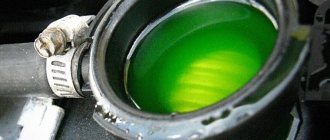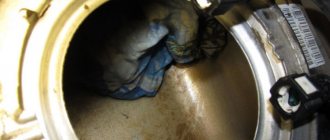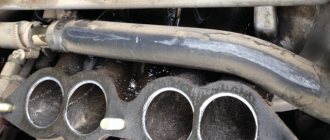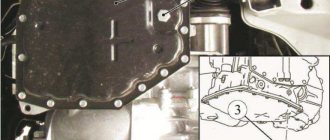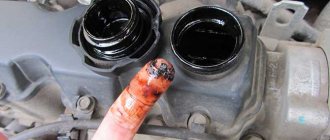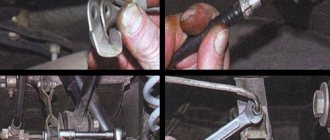0 rub.
Replacing antifreeze on a VAZ 2107
Antifreeze replacement in domestic VAZ 2107 cars is carried out at standard intervals - once every 2 years or after 60,000 km. It all depends on which condition is met first. In addition, the fluid must be replaced if it has changed color, for example, acquired a reddish tint.
Which antifreeze is better, and how much should I fill it with?
Before draining the antifreeze, you must decide on the brand of new coolant and purchase it in the required volume. VAZ 2107 cars require 9.85 liters to fully refill the cooling system. This means that one 10-liter container of antifreeze will be enough. When purchasing coolant, please note that some antifreezes are sold in the form of concentrates and require dilution with distillate in a 1 to 1 ratio.
To replace antifreeze, you can use the following types:
- For “sevens” from 1998 to 2002, the optimal coolant option is G12 red. This includes MOTUL Ultra, Lukoil Ultra, Castrol SF and others.
- In VAZ 2107, manufactured from 2003 to 2012 and beyond, it is recommended to use G12+ or G12++ antifreeze of the following brands - MOTUL Ultra, Castrol Radicool Si, Zerex G.
Replacement process
Before draining the antifreeze, stock up on the necessary tools. You will need a minimum set, which includes a key for “thirteen”, a group of screwdrivers, a container (this is where the old coolant will be drained), as well as 10 liters of the new composition in a canister.
Replacing antifreeze begins with draining the old working fluid. To begin, find a flat surface to perform all manipulations. It is better to work on an overpass or pit, in a garage. If it is not possible to park the car level, the front part can be raised slightly higher than the rear (the reverse situation is excluded).
Then proceed like this:
- If present, remove the engine protection. To do this, just unscrew the twelve fastening bolts. Also remember that there are four plastic fasteners.
- Go to the salon and move the lever to the right, which is responsible for the release of warm air from the heating system in the car's interior. As a rule, it is located on top.
- Open the expansion tank. Assess the condition of its plug and, if there are defects, replace it.
- Open the filler neck at the top of the car's radiator.
- Unscrew the plug that closes the coolant outlet from the engine cylinder block. Before draining the antifreeze, place an empty container (bucket or bottle) to remove the old coolant.
- Move the container or place a new container under the radiator, then open its drain. Wait until the old coolant is completely out of the system.
- Discard the belt that holds the expansion tank. Now lift the tank up to drain the antifreeze from the connected tube. The remaining coolant, in this case, exits through the drain in the radiator.
- Leave the car for a while to ensure that the coolant has completely drained out.
Filling with new antifreeze
Now proceed to replacing the antifreeze. To do this, proceed like this:
- Return the cooling system reservoir to its original place and screw the plug onto the drain hole of the VAZ 2107 cylinder block. Do the same with the drain plug on the radiator - screw it into place.
- Pour new antifreeze into the radiator, and then do the same work for the expansion tank. Monitor the position of the coolant in the system using the control marks. Stop pouring antifreeze when the line is 3-4 cm above the MIN line.
Replacing antifreeze on classics (VAZ-2101 - VAZ-2107 cars)
Comments, interesting explanations on the question “how much does a liter volume weigh” and some additional information on reference data on physical properties.
In fact, we have 1 liter of antifreeze, a liter can or a certain amount known in liters, we want to find out the mass: how much does it weigh in kg or grams. That is, our task is to determine how much it weighs: recalculate liters of antifreeze - units of measurement of volume into kilograms - units of measurement of the weight of antifreeze. Having determined the volumetric mass of 1 liter of antifreeze, how much in kilograms, without weighing on a scale. Find out how much it weighs (for example: a liter jar), based on calculated, theoretical, reference data from the table of physical properties: specific gravity and density of antifreeze. It is better, of course, not to use the true density, but the bulk density, if you can find the bulk density in the reference book. Which is actually not so easy to do in practice. It is extremely inconvenient to independently recalculate based on physical properties, also because most tables, GOSTs, TUs give values of specific gravity and density “tied” not to a liter jar, but in other units: tons/m3, kg/m3, kg/cube, g/cm3. If you wish, you can spend a lot of time, find data, perform the recalculation yourself and find out how many kg there will be in a liter volume. However, this option to find out how much a liter volume weighs is not a simple and convenient way for everyone, especially since it requires searching for additional information on the bulk density of antifreeze and its specific gravity, plus knowledge of the conversion formula. Therefore, we made such a recalculation ourselves based on the physical properties given in GOST and TU, indicated the mass of 1 liter of antifreeze in kg, a liter can, giving it in a separate table of weights and volumes. An extract from the general table is given above. Question: how many kg are in one liter of antifreeze, liter volume. Answer: see bulk density in Table 1. How to find out how much it weighs - measure the mass of antifreeze with a liter jar, independently, without weighing it on a scale. On our website you can find other interesting practical information on density and specific gravity not listed in conventional reference books, tables, GOSTs and specifications, which is not so easy to find on the Internet. For example, for the more familiar units of volume: cm3, m3, cube, cubic meter, cubic meter. Household and cutlery measuring products: teaspoon, tablespoon, glass. More construction, gardening, manufacturing and industrial: shovels (bayonet and scoop), packs, buckets, bags, pallets, barrels, construction or garden wheelbarrows. Transport: tank car, railway tank, railway car, on-board vehicle, truck, dump truck. These are so-called non-standard containers, often used in practice. Despite all the variety of containers, each of them has its own displacement. This means that it is possible to recalculate the mass of the load in kg using the values indicated in Table 1. Naturally, this technique has its own errors. In this case, the error in calculating the mass of a large displacement will be higher than the error in determining the mass of a liter volume indicated in Table 1.
Answer or solution 1
Antifreeze weighs slightly more than water. The weight of one liter of antifreeze is approximately 1.07 kilograms.
Let's take x to be the number of liters of antifreeze in a given barrel. We solve using proportion:
x liters – 220 kg.
The proportion is direct, let's express x from here:
x = 220 * 1: 1.07 = 205.6 liters - antifreeze is in the barrel.
Answer: there are 205.6 liters of antifreeze in the barrel.
Table 1. How many kg are in 1 liter of antifreeze. Liter standards. A measuring tool for determination without scales is a liter jar. How much is the volumetric weight of antifreeze in one liter - kg/liter, at its normal density under normal conditions, the quality, chemical composition and physical properties are declared in GOST, correspond to the manufacturer’s specifications.
Recalculate, find out volumetric weight: physical properties.Quantities.Amount of kg in 1 liter, kg/liter.For calculations, reference data was used from:Now you can find out how much it weighs using a tool such as:Measurement error.–How many kg are in 1 liter of antifreeze - a liter jar.We use reference data on density and specific gravity, calculating using the formula to obtain the volumetric weight. 1.13 Handbook of physical properties, GOST, TU. Liter jar. up to 5% –Comments, interesting explanations on the question “how much does a liter volume weigh” and some additional information on reference data on physical properties.
In fact, we have 1 liter of antifreeze, a liter can or a certain amount known in liters, we want to find out the mass: how much does it weigh in kg or grams. That is, our task is to determine how much it weighs: recalculate liters of antifreeze - units of measurement of volume into kilograms - units of measurement of the weight of antifreeze. Having determined the volumetric mass of 1 liter of antifreeze, how much in kilograms, without weighing on a scale. Find out how much it weighs (for example: a liter jar), based on calculated, theoretical, reference data from the table of physical properties: specific gravity and density of antifreeze. It is better, of course, not to use the true density, but the bulk density, if you can find the bulk density in the reference book. Which is actually not so easy to do in practice. It is extremely inconvenient to independently recalculate based on physical properties, also because most tables, GOSTs, TUs give values of specific gravity and density “tied” not to a liter jar, but in other units: tons/m3, kg/m3, kg/cube, g/cm3. If you wish, you can spend a lot of time, find data, perform the recalculation yourself and find out how many kg there will be in a liter volume. However, this option to find out how much a liter volume weighs is not a simple and convenient way for everyone, especially since it requires searching for additional information on the bulk density of antifreeze and its specific gravity, plus knowledge of the conversion formula. Therefore, we made such a recalculation ourselves based on the physical properties given in GOST and TU, indicated the mass of 1 liter of antifreeze in kg, a liter can, giving it in a separate table of weights and volumes. An extract from the general table is given above. Question: how many kg are in one liter of antifreeze, liter volume. Answer: see bulk density in Table 1. How to find out how much it weighs - measure the mass of antifreeze with a liter jar, independently, without weighing it on a scale. On our website you can find other interesting practical information on density and specific gravity not listed in conventional reference books, tables, GOSTs and specifications, which is not so easy to find on the Internet. For example, for the more familiar units of volume: cm3, m3, cube, cubic meter, cubic meter. Household and cutlery measuring products: teaspoon, tablespoon, glass. More construction, gardening, manufacturing and industrial: shovels (bayonet and scoop), packs, buckets, bags, pallets, barrels, construction or garden wheelbarrows. Transport: tank car, railway tank, railway car, on-board vehicle, truck, dump truck. These are so-called non-standard containers, often used in practice. Despite all the variety of containers, each of them has its own displacement. This means that it is possible to recalculate the mass of the load in kg using the values indicated in Table 1. Naturally, this technique has its own errors. In this case, the error in calculating the mass of a large displacement will be higher than the error in determining the mass of a liter volume indicated in Table 1.
| Home News Metal structures Gallery Contacts |
| © PE Kolesnik 2010-2011 |
Our address: Dnepropetrovsk, st. Karl Liebknechta 57 Phone in Ukraine: (063) 796-79-32 or (063) 796-19-32
How to replace antifreeze on a VAZ 2107?
If you are in doubt about the state of antifreeze or antifreeze in your car’s cooling system, then know that the freezing temperature can be determined by the density of the coolant. Here we will tell you how to do this if your antifreeze or antifreeze is based on ethylene glycol. This is the majority of antifreezes and antifreezes today. More details in the article “Types of antifreeze and antifreeze.”
So, different ratios of ethylene glycol and water accordingly form different densities. So, in particular, 1 liter of water weighs 1 kg, but 1 liter of ethylene glycol is already 1.120 kg, so from determining the weight in 1 liter, that is, in fact, from determining the density, one can conclude about the content of ethylene glycol in water and, as a result, summarize the freezing point for a given antifreeze or antifreeze. The density of antifreeze and antifreeze is measured with a hydrometer or other similar, easy-to-use device. As a rule, this is an ordinary float that sinks to different depths depending on density. Indeed, at different densities, the Archimedes force will also be different; the Archimedes force is a force equal to the mass of the displaced solution by the volume of the body immersed in it.
Table of the relationship between density and freezing point of antifreeze or antifreeze
Density of antifreeze, antifreeze g/cm3
In addition, for those who prefer a more visual representation in the form of a graph, the dependence of density on the percentage content and freezing temperature can also be expressed graphically.
WATER SUPPLY AND SEWERAGE DESIGN
Working hours: Mon-Fri from 9-00 to 18-00 (without lunch)
How many kilograms are in a liter of antifreeze
Mass is a characteristic of a body, which is a measure of gravitational interaction with other bodies.
Volume is a quantitative characteristic of the space occupied by a body, structure or substance.
Density is a physical quantity defined as the ratio of body mass to body volume.
The relationship between liters and kilograms of antifreeze is determined by a simple mathematical formula:
V—volume; m—mass; p—density.
In the calculation, the density of antifreeze was taken = 1070 kg/m3.
Antifreeze kg to liters
Mass is a characteristic of a body, which is a measure of gravitational interaction with other bodies.
Volume is a quantitative characteristic of the space occupied by a body, structure or substance.
Density is a physical quantity defined as the ratio of body mass to body volume.
The relationship between liters and kilograms of antifreeze is determined by a simple mathematical formula:
V – volume; m – mass;
p – density.
In the calculation, the density of antifreeze was taken = 1112 kg/m3.
The density of antifreeze can vary depending on temperature and pressure. You can find the exact density of antifreeze in reference books.
See also the universal program for converting liters to kg for any substance depending on its density.
If you need to convert m3 to tons, then see the program for converting tons to m3.
If you need to convert kg to m3, then see the program for converting kg to m3.
Question: How many kg are in a liter of antifreeze?
Answer: 1 kg of antifreeze is equal to 0.899 liters.
Question: How many liters are in a kilogram of antifreeze?
Answer: 1 liter of antifreeze is equal to 1.112 kilograms (kg).
You can quickly solve this simple mathematical operation using our online program. To do this, enter the initial value in the appropriate field and click the button.
This page presents the simplest program for converting kilograms of antifreeze into liters. With this online calculator you can convert liters of antifreeze to kg and back in one click.
It's no secret that the most important thing in a car is the engine. Its efficient operation depends not only on high-quality fuel and an appropriate lubrication system, but also on the cooling system. And throughout the history of the car, designers have addressed the issue of increasing the efficiency of the car's engine cooling system with the help of.
History of coolants (antifreeze)
The first engines of the 19th century were air-cooled.
Around 1900, water-cooled engines appeared.
Since the 1930s, pumps and thermostats have been used for the first time to increase cooling efficiency.
Early coolants or antifreezes were:1. Saline solutions of sodium and calcium chlorides.2. Solutions of glycerin, sugar and honey.
3. Methyl and ethyl alcohols.
Since 1930, ethylene glycol has been used for the first time.
Since 1939, special anti-corrosion packages have been used.
Basic requirements for modern antifreezes
1. Thermal characteristics that allow you to effectively cool the engine without boiling.2. Anti-corrosion protection of all metals and alloys in the cooling system of modern cars.3. Frost protection depending on the selected concentration.4. Compatible with rubber and plastic products in the cooling system.5. Excellent anti-foam characteristics.6. Stability of characteristics throughout the service life.
7. Lack of nitrites, amines, phosphates.
Basic national standards of antifreeze (antifreeze, coolants)
BS 6580: 1992 (UK) AFNOR NF R15-601 (France) ASTM D 3306 (USA) SAE J 1034 (USA) ONORM V5123 (Austria) JIS K2234 (Japan)
CUNA NC956 16 (Italy)
Why is a car engine cooling system necessary?
Combustion of the fuel mixture in the engine occurs at temperatures of 2100–2300°C. At this temperature, without forced cooling, engine parts would heat up to a temperature significantly higher than the ignition temperature of the oil.
In addition to oil combustion, when the engine overheats, the frictional forces and wear of parts increase, thermal clearances decrease, oil coking and carbon deposits occur, and the filling of the cylinders of carburetor engines with the combustible mixture, and of diesel engines with purified air, worsens.
At the same time, excessive heat removal leads to engine overcooling and a change in the viscosity properties of the oil, which leads to increased wear of parts, a decrease in engine power and efficiency. The ideal thermal regime of the engine is 85-95°C, regardless of its load and ambient temperature.
To stay warm
In winter conditions, antifreezes—liquids with a low freezing point—are used as coolants. These are mainly ethylene glycol based formulations. The freezing point of a mixture of ethylene glycol and water (1:1) is approximately 36°C. A remarkable property of this ratio and higher concentration is that at lower temperatures the mixture does not turn into ice, but forms a thick mass without causing damage to the cylinder block and radiator.
Antifreeze - so as not to boil
In addition to the freezing point, the boiling temperature of the coolant is also important - the higher it is, the less it evaporates and the less often it boils, which ensures longer engine operation without refueling and overheating. The average boiling point of a mixture of ethylene glycol and water (1:1) is +107°C.
What to do?
• Use antifreeze that meets your vehicle manufacturer's specifications.
• If you bought a car and don’t know what was poured into it and when, it is better to replace all technical fluids (oil, antifreeze, brake fluid).
• To add, use the same brand of antifreeze. Different manufacturers may use incompatible additive packages.
• Whatever the perfect antifreeze, it is necessary to regularly monitor its level according to the marks in the expansion tank and the concentration using a glycometer, due to the formation of condensation, possible leaks and evaporation, and also replace it within the time specified in the instructions for the car by the manufacturer .
Is it possible to focus on color when choosing antifreeze?
Every hunter wants to know where the pheasant is sitting.
Red, orange, yellow, green, blue, indigo, violet, turquoise, crimson and different shades. It is impossible to determine the quality or compatibility of antifreeze from different manufacturers by color. Color is not a quality, it is a dye.
THIS IS INTERESTING: How much antifreeze is in the VAZ 2107 injector
Source: https://mvpclub.ru/antifriz-kg-v-litry/
